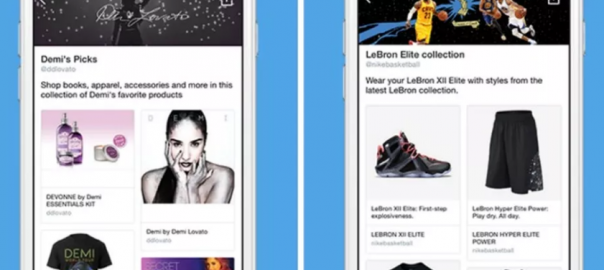Social media has long been the go-to catalog for ecommerce products. Shoppers “unbox” items on YouTube, pin styles on Pinterest, post fashion photos on Instagram, and share finds with friends on Facebook.
But could it soon become the place to actually buy those items?
The social media titans are certainly hoping so. They’re releasing features that allow viewers to shop products directly through their platforms, hoping to capitalize on how users already behave.
Instagram recently added a “shop now” button. Twitter is launching product pages, which allow users to browse and buy, according to Recode. And Facebook has allowed brands to use a “buy” button since 2014. Even Snapchat is weighing in—MarketingWeek reports that the newly-public company is building its own ecommerce platform.
 Image Credit: Twitter
Image Credit: Twitter
No doubt, exciting changes are underway.
Yet some brands are still skeptical. Many harbor the fear of building their house on “rented land” and giving up control to social media platforms which have already consumed so much of their revenue through advertising. “Social media isn’t a platform for selling,” said Andy Atkinson, Marketing Director at food giant Morrison, in a MarketingWeek article, implying that marketers who adopt these channels were making a “mistake.”
Yet the choice may not be theirs to make. Today’s consumers are driving the conversation on social and they increasingly turn to these platforms for buying inspiration. Here are some facts:
- 56% of consumers who follow brands on social media do so to browse products (Anima)
- 31% of online shoppers say that they use social media to browse items (American Marketing Association)
And while they come here for much more than shopping, the potential exposure for brands is difficult to ignore. Facebook alone boasts one in seven people on Earth among its users, followed by Instagram, Twitter, Snapchat, and Pinterest. As far as potential markets go, it doesn’t get much bigger than this. Plus, users are already begging for engagement from brands here for things like customer support.
According to a Conversocial study, customer service related inquiries on Twitter are up 250% over the past two years, and nearly every platform has released additional functionality to allow brands to provide complaint resolution. It’s clear that consumers want to interact with brands in ways that are easiest for them: through the social, mobile channels that they already use so heavily.
In this light, social selling seems like something of the inevitable future. Brands will have to go where their consumers are. And while some may object to allowing social media to be their all-in-one interface with their consumers, the model has been rather successfully pioneered in international markets like Asia to great success.
As The Economist reports, WeChat is China’s Swiss army knife of messaging apps and already allows users to do everything from video calls and music sharing to booking doctor’s appointments, finding a date, and of course, ecommerce shopping.
WeChat’s users can “shop online, to pay for goods at physical stores, settle utility bills and split dinner tabs with friends, just with a few taps. [They] can easily book and pay for taxis, dumpling deliveries, theatre tickets, hospital appointments and foreign holidays, all without ever leaving the WeChat universe.”
In short, businesses have embraced the social sale. They value the tight integration they gain into their consumer’s lives and the ability to be one-click away from a purchase at all times.
Will domestic brands feel the same about a social selling ecommerce future? If the social media platforms and consumers have anything to say about it, they just might have to.
What’s your take—will social selling be the future of ecommerce? To learn more about the State of Social Customer Service and how you can build customer loyalty, download our 2017 report.
Digital & Social Articles on Business 2 Community(73)








